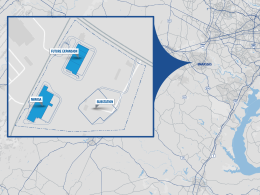Amazon’s AI-powered tool, FlowMS is uncovering a hidden water leak at a Glasgow logistics facility. The system, designed to enhance efficiency and sustainability, identified an underground pipeline fault that had gone unnoticed by the human eye. This discovery, made possible through advanced data analysis, prevented the loss of approximately nine million gallons of water annually.
FlowMS, built using Amazon Web Services (AWS), identified the anomaly after analysing metering data and detecting an unusual increase in water usage at the site. The system promptly alerted Amazon employees, leading engineers to trace the leak to underground piping. The early intervention prevented the loss of approximately nine million gallons of water per year.
The AI-driven tool is part of a broader suite of advanced monitoring systems Amazon has implemented to enhance operational efficiency and reduce environmental impact. These innovations have already delivered substantial results, from identifying inefficiencies in utility meters to mitigating energy losses at loading docks and reducing food waste.
“At Amazon, we’re innovating with AI to accelerate decarbonisation, including developing new solutions that enhance the energy and water efficiency of our buildings,” said Kara Hurst, Amazon’s chief sustainability officer. “This is just one example of how we are leveraging our decades of experience in AI and sustainability to drive operational efficiency and reduce emissions.”
With buildings and construction accounting for 40% of global greenhouse gas emissions, according to the Carbon Leadership Forum, Amazon has prioritised sustainability as part of its Climate Pledge commitment. The company is integrating practical AI-powered solutions such as FlowMS alongside other in-house technologies to meet its environmental goals.
Beyond FlowMS, Amazon’s Decision Science & Technology team has developed the Base Building Advanced Monitoring (BBAM) tool, which employs AWS’s machine learning capabilities, including Amazon SageMaker and Lambda, to monitor HVAC systems. BBAM analyses operational data, energy consumption, and local weather conditions to detect inefficiencies such as clogged filters and unexpected energy consumption due to weather fluctuations.
At a New York fulfilment centre, FlowMS detected an energy discrepancy where the building appeared to be consuming five times more power than comparable sites. Further investigation revealed a miscalibrated utility meter, ensuring accurate reporting and energy efficiency improvements. Similarly, in Spain, BBAM identified a malfunctioning air conditioning unit by comparing cooling output with expected demand based on real-time weather data. This early intervention allowed teams to address the issue before it disrupted operations.
Amazon is now deploying BBAM at fulfilment and delivery sites to monitor dock doors, reducing energy losses caused by doors being accidentally left open. Currently operational at 120 sites, the company plans to expand FlowMS and BBAM to over 300 buildings worldwide by the end of 2025.
Another AI tool, Advanced Refrigeration Monitoring (ARM), has been introduced to oversee refrigeration units in fulfilment centres. ARM analyses energy consumption patterns to maintain optimal temperatures for perishable goods, predicting potential faults such as clogged compressors or insulation failures. In Spain, the system detected an anomaly in a refrigeration unit’s defrost cycle, allowing teams to rectify the fault before significant food waste or downtime occurred. Amazon now operates ARM across its grocery network in North America and Europe, with plans to extend its reach to over 150 sites, including in India, by the end of 2025.
AI-powered solutions like FlowMS, BBAM, and ARM are integral to Amazon’s sustainability strategy, supporting its goal to reach net-zero carbon emissions by 2040. By leveraging technology to optimise building efficiency and reduce waste, the company continues to advance its commitment to environmental responsibility on a global scale.





















